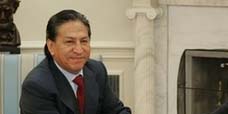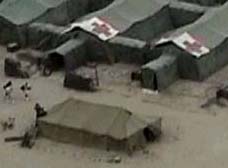2006.08.19: August 19, 2006: Headlines: AIDS: AIDS Education: MSNBC: Dr. Helene Gayle co-chair of the International AIDS Conference explains why HIV-prevention efforts have fallen short and what needs to be done now
Peace Corps Online:
Peace Corps News:
Library:
Peace Corps: AIDS Education :
The Peace Corps and AIDS Education:
2006.08.12: August 12, 2006: Headlines: AIDS Education: PCOL Exclusive: The Peace Corps and AIDS Education :
2006.08.13: August 13, 2006: Headlines: Fund Raising: Philanthropy: AIDS: New York Times: The Bill and Melinda Gates Foundation is facing an unparalleled challenge: how to give away more money — and do it much faster — than it ever has before :
2006.08.19: August 19, 2006: Headlines: AIDS: AIDS Education: MSNBC: Dr. Helene Gayle co-chair of the International AIDS Conference explains why HIV-prevention efforts have fallen short and what needs to be done now
Dr. Helene Gayle co-chair of the International AIDS Conference explains why HIV-prevention efforts have fallen short and what needs to be done now
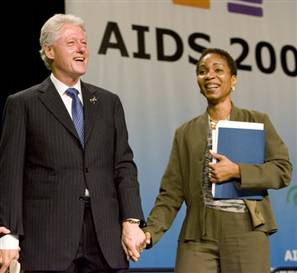
"Over the last few years, attention has shifted to treatment and away from prevention. It’s no surprise. Unlike prevention, which involves taboo subjects like sex and drug use, treatment is a more neutral issue. When you have the tools to keep huge numbers of infected people from dying, you have to do it. We absolutely should not cut back on treatment. But we’ve got to do more to integrate better prevention and treatment. If we don’t, we’ll fail. Part of the problem is that you have different people focusing on different parts of the response. You have doctors focusing solely on treatment while community organizations try to handle prevention. Too often, they’re not working together. Testing, treatment and prevention counseling need to be much better coordinated."
Dr. Helene Gayle co-chair of the International AIDS Conference explains why HIV-prevention efforts have fallen short and what needs to be done now
'We Need to Change the Social Norms'
The co-chair of the International AIDS Conference explains why HIV-prevention efforts have fallen short and what needs to be done now.
By Geoffrey Cowley
Newsweek
Caption: Gayle at the World AIDS Conference this week with former U.S. President Bill Clinton Photo: Freank Gunn/AP
Updated: 9:50 p.m. ET Aug 18, 2006
Aug. 17, 2006 - The 25th year of the global AIDS epidemic has been heralded as the “least bad” year yet. Across the developing world, more than 400,000 people gained access to lifesaving treatments last year, and a few hard-hit countries have reported declining HIV infection rates. But as Bill Gates cautioned in an address to the International AIDS Conference in Toronto this week, current trends don’t bode well for the future. For each person who started anti-HIV therapy last year, 10 more contracted the virus. “When you extrapolate five to 10 years,” Gates noted, “you quickly see that there is no feasible way to … treat everyone …. unless we dramatically reduce the number of new infections.”
Preventing infections may lack the glamour of saving the sick, but it remains the key to ending AIDS. What are the obstacles, and what will it take to surmount them? NEWSWEEK's Geoffrey Cowley spoke to Dr. Helene Gayle, the president and CEO of CARE, a humanitarian organization, and co-chair of the International AIDS Conference. Excerpts:
NEWSWEEK: International funding reached $8 billion this year. Why have we had so little luck in stopping the spread of HIV?
Dr. Helene Gayle: Over the last few years, attention has shifted to treatment and away from prevention. It’s no surprise. Unlike prevention, which involves taboo subjects like sex and drug use, treatment is a more neutral issue. When you have the tools to keep huge numbers of infected people from dying, you have to do it. We absolutely should not cut back on treatment. But we’ve got to do more to integrate better prevention and treatment. If we don’t, we’ll fail. Part of the problem is that you have different people focusing on different parts of the response. You have doctors focusing solely on treatment while community organizations try to handle prevention. Too often, they’re not working together. Testing, treatment and prevention counseling need to be much better coordinated.
What lessons have we learned about prevention? Have the efforts of the past 25 years made any appreciable difference?
Prevention is invisible. When it works, nothing happens except that people who were healthy stay that way. We’ll never know exactly how many of the people now using condoms or abstaining from sex or sticking to one partner might have ended up HIV-positive otherwise. We can’t purposely exclude people from prevention efforts to find out. But it’s clear that prevention efforts can work. HIV rates have decreased in countries like Uganda and Thailand and now in some countries in eastern and southern Africa. When people enroll in trials to test microbicides [topical agents that may prevent HIV transmission] or preventive drug therapies, their rate of HIV transmission often drops because they receive intensive prevention counseling, access to condoms and treatment for their other sexually transmitted diseases. This may explain why the first microbicide trial, done several years ago, couldn’t detect a difference between those who used the product and those who didn’t.
But most people now know how HIV spreads. Knowledge alone doesn’t seem to provide much protection.
Information and education are critical, but they’re not enough. When Thailand wanted to stop HIV transmission in the brothels, it didn’t just suggest that people use condoms. It took a proactive approach and adopted a 100 percent rule. Brothels that didn’t enforce condom use were shut down like restaurants with code violations, and it worked. The transmission rate fell and the country averted a disaster.
The Bush administration’s ABC approach [abstain, be faithful, use condoms] has been criticized for overlooking the social issues that place women at risk. If your partner isn’t faithful, and you lack the power to refuse unprotected sex with him, ABC doesn’t offer you much protection.
ABC can work if it’s part of a balanced and comprehensive prevention strategy. Uganda’s experience shows that. When children started delaying their sexual debut, and people embraced condoms and partner reduction, the infection rate came down. But there are limits to that approach, especially for women. Social, cultural and political factors make some people more vulnerable to HIV. If you’re a woman lacking food for your kids, sex may be the only asset you can sell. You’re not in a good position to dictate the terms. Women who are themselves monogamous may be in relations with partners who have multiple partners and won’t use a condom. Women in many societies don’t have the social power to negotiate safer sex or control sexual interaction, including within marriage.
Is anyone coming up with good, practical ways to address these deeper sources of risk?
I just visited a community-based savings-and-loan program that CARE supports in Guatemala. CARE has similar programs in Africa and in Asia. This program provides small loans that women can use to start businesses if they send their daughters to school. Woman after woman described how earning money had raised her stature within her family and marriage. The girls said the same thing about going to school. They were headed for lives where they would be able to make their own choices. We can’t do away with poverty overnight, but we can counter some of its worst effects. We also need to change the social norms that condone coercive sex and treat women as property. How do you make it unacceptable for schoolmasters to harass young girls? You prosecute them for it.
What are the big remaining challenges for governments and foundations and international health agencies?
We need to develop new tools. Diaphragms, circumcision, microbicides, treatment of herpes, oral prevention drugs and, ultimately, a vaccine—these technologies may all have roles to play. We’re making rapid progress toward effective microbicides, and we can hope that antiretroviral drugs will help prevent HIV infection as well as they treat it. But these technologies are at least five to seven years from the market, and technology alone won’t solve the problem. Condoms are cheap, simple and highly effective, but they’re still underused. Only one in five people at risk for HIV has access to existing prevention approaches like education, condoms, HIV testing and treatment of other sexually transmitted disease. Even the best prevention programs typically reach only 10 to 30 percent of the people who could benefit. We need to get to a tipping point where we’re reaching at least 50 percent of people at risk. Then we will start to see greater impact.
© 2006 Newsweek, Inc.
When this story was posted in August 2006, this was on the front page of PCOL:





Peace Corps Online The Independent News Forum serving Returned Peace Corps Volunteers
 | Peace Corps' Screening and Medical Clearance
The purpose of Peace Corps' screening and medical clearance process is to ensure safe accommodation for applicants and minimize undue risk exposure for volunteers to allow PCVS to complete their service without compromising their entry health status. To further these goals, PCOL has obtained a copy of the Peace Corps Screening Guidelines Manual through the Freedom of Information Act (FOIA) and has posted it in the "Peace Corps Library." Applicants and Medical Professionals (especially those who have already served as volunteers) are urged to review the guidelines and leave their comments and suggestions. Then read the story of one RPCV's journey through medical screening and his suggestions for changes to the process. |
 | Gates charity races to spend billions
Warren E. Buffett’s gift of $31 billion to the Bill and Melinda Gates Foundation means that for tax reasons, starting in 2009, the foundation must distribute $3 billion annually, or a little more than twice what it distributed last year.
PCOL Comment: The Foundation says that "preventing the spread of HIV is the most durable long-term solution to the AIDS epidemic, and a top priority for the foundation." Peace Corps Volunteers and Returned Volunteers have been doing just that in AIDS Education for the past 15 years. Why not consider a $100M annual contribution to the Peace Corps to put 2,500 additional volunteers in the field to expand AIDS education worldwide? |
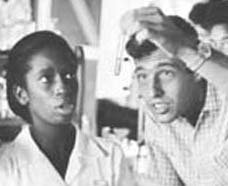 | The Peace Corps is "fashionable" again
The LA Times says that "the Peace Corps is booming again and "It's hard to know exactly what's behind the resurgence." PCOL Comment: Since the founding of the Peace Corps 45 years ago, Americans have answered Kennedy's call: "Ask not what your country can do for you--ask what you can do for your country. My fellow citizens of the world: ask not what America will do for you, but what together we can do for the freedom of man." Over 182,000 have served. Another 200,000 have applied and been unable to serve because of lack of Congressional funding. The Peace Corps has never gone out of fashion. It's Congress that hasn't been keeping pace. |
 | Changing the Face of Hunger
In his new book, Former Congressman Tony Hall (RPCV Thailand) says humanitarian aid is the most potent weapon the United States can deploy against terrorism. An evangelical Christian, he is a big believer in faith-based organizations in the fight against hunger. Members of Congress have recently recommended that Hall be appointed special envoy to Sudan to focus on ending the genocide in Darfur. |
 | PC will not return to East Timor in 2006
Volunteers serving in East Timor have safely left the country as a result of the recent civil unrest and government instability. Latest: The Peace Corps has informed us that at this time, the Peace Corps has no plans to re-enter the country in 2006. The Peace Corps recently sent a letter offering eligible volunteers the opportunity to reinstate their service in another country. |
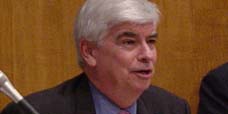 | Chris Dodd considers run for the White House
Senator Chris Dodd plans to spend the next six to eight months raising money and reaching out to Democrats around the country to gauge his viability as a candidate. Just how far Dodd can go depends largely on his ability to reach Democrats looking for an alternative to Hillary Clinton. PCOL Comment: Dodd served as a Volunteer in the Dominican Republic and has been one of the strongest supporters of the Peace Corps in Congress. |
 | Vasquez testifies before Senate Committee
Director Vasquez testifies before the Senate Foreign Relations Committee on his nomination as the new Representative to the United Nations Agencies for Food and Agriculture replacing Tony Hall. He has been the third longest serving Peace Corps Director after Loret Ruppe Miller and Sargent Shriver. PCOL Comment: Read our thanks to Director Vasquez for his service to the Peace Corps. |
 | Peace Corps stonewalls on FOIA request
The Ashland Daily Tidings reports that Peace Corps has blocked their request for information on the Volkart case. "After the Tidings requested information pertaining to why Volkart was denied the position — on March 2 — the newspaper received a letter from the Peace Corps FOIA officer stating the requested information was protected under an exemption of the act." The Dayton Daily News had similar problems with FOIA requests for their award winning series on Volunteer Safety and Security. |
 | PCOL readership increases 100%
Monthly readership on "Peace Corps Online" has increased in the past twelve months to 350,000 visitors - over eleven thousand every day - a 100% increase since this time last year. Thanks again, RPCVs and Friends of the Peace Corps, for making PCOL your source of information for the Peace Corps community. And thanks for supporting the Peace Corps Library and History of the Peace Corps. Stay tuned, the best is yet to come. |
 | History of the Peace Corps
PCOL is proud to announce that Phase One of the "History of the Peace Corps" is now available online. This installment includes over 5,000 pages of primary source documents from the archives of the Peace Corps including every issue of "Peace Corps News," "Peace Corps Times," "Peace Corps Volunteer," "Action Update," and every annual report of the Peace Corps to Congress since 1961. "Ask Not" is an ongoing project. Read how you can help. |
 | RPCV admits to abuse while in Peace Corps
Timothy Ronald Obert has pleaded guilty to sexually abusing a minor in Costa Rica while serving there as a Peace Corps volunteer. "The Peace Corps has a zero tolerance policy for misconduct that violates the law or standards of conduct established by the Peace Corps," said Peace Corps Director Gaddi H. Vasquez. Could inadequate screening have been partly to blame? Mr. Obert's resume, which he had submitted to the Peace Corps in support of his application to become a Peace Corps Volunteer, showed that he had repeatedly sought and obtained positions working with underprivileged children. Read what RPCVs have to say about this case. |
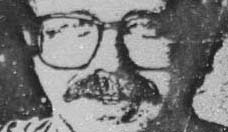 | Why blurring the lines puts PCVs in danger
When the National Call to Service legislation was amended to include Peace Corps in December of 2002, this country had not yet invaded Iraq and was not in prolonged military engagement in the Middle East, as it is now. Read the story of how one volunteer spent three years in captivity from 1976 to 1980 as the hostage of a insurrection group in Colombia in Joanne Marie Roll's op-ed on why this legislation may put soldier/PCVs in the same kind of danger. Latest: Read the ongoing dialog on the subject. |
Read the stories and leave your comments.

Some postings on Peace Corps Online are provided to the individual members of this group without permission of the copyright owner for the non-profit purposes of criticism, comment, education, scholarship, and research under the "Fair Use" provisions of U.S. Government copyright laws and they may not be distributed further without permission of the copyright owner. Peace Corps Online does not vouch for the accuracy of the content of the postings, which is the sole responsibility of the copyright holder.
Story Source: MSNBC
This story has been posted in the following forums: : Headlines; AIDS; AIDS Education
PCOL34134
12











